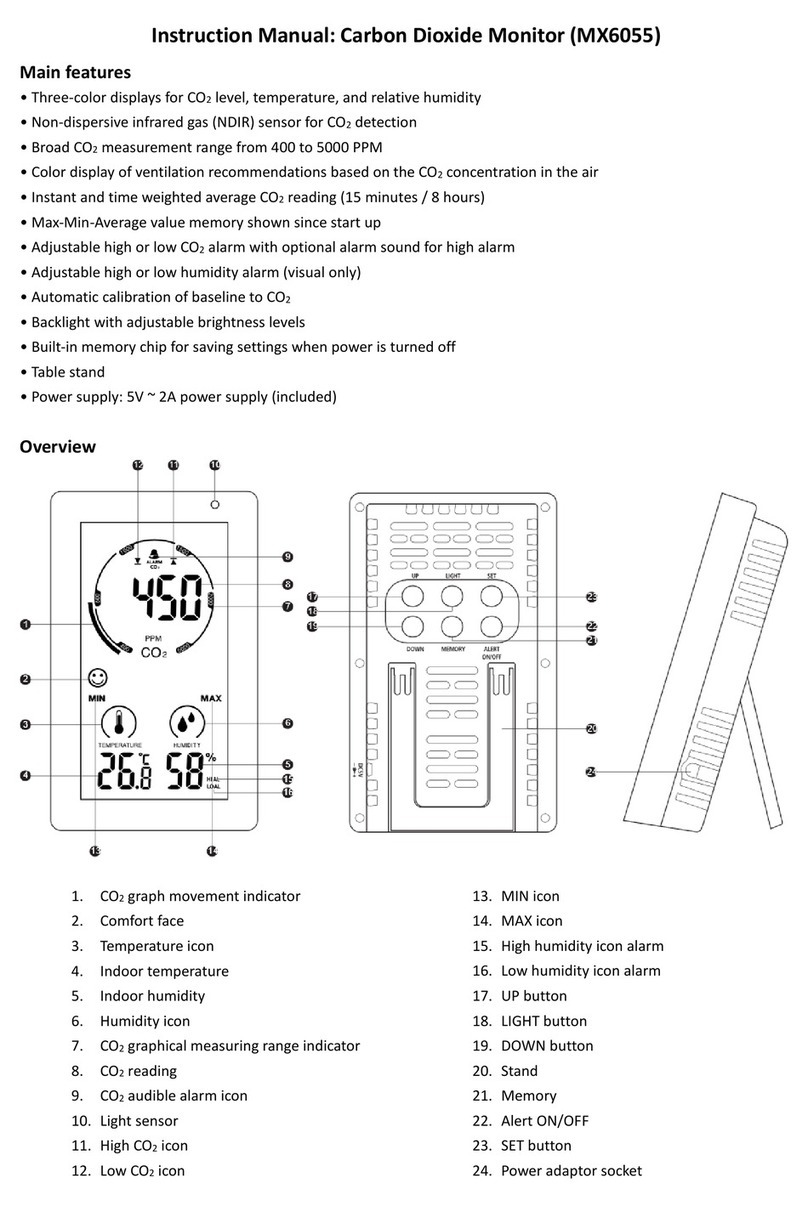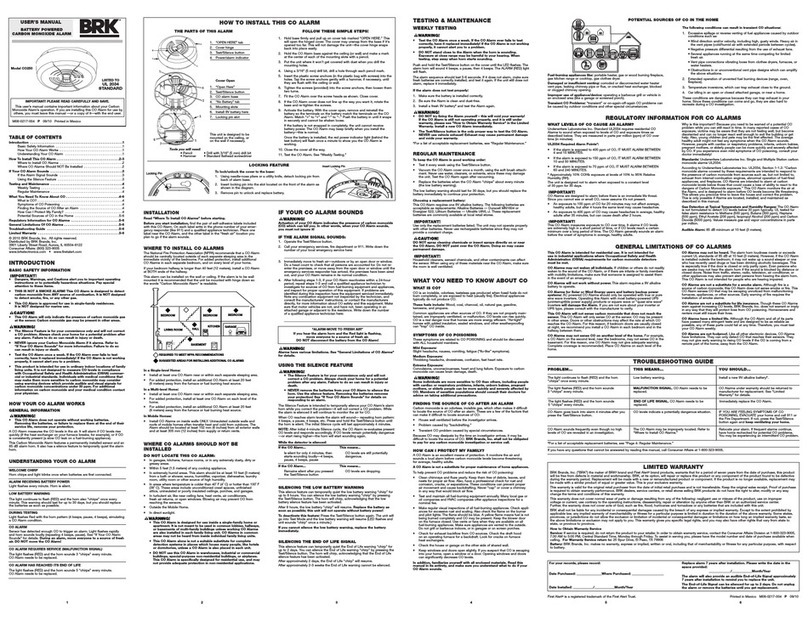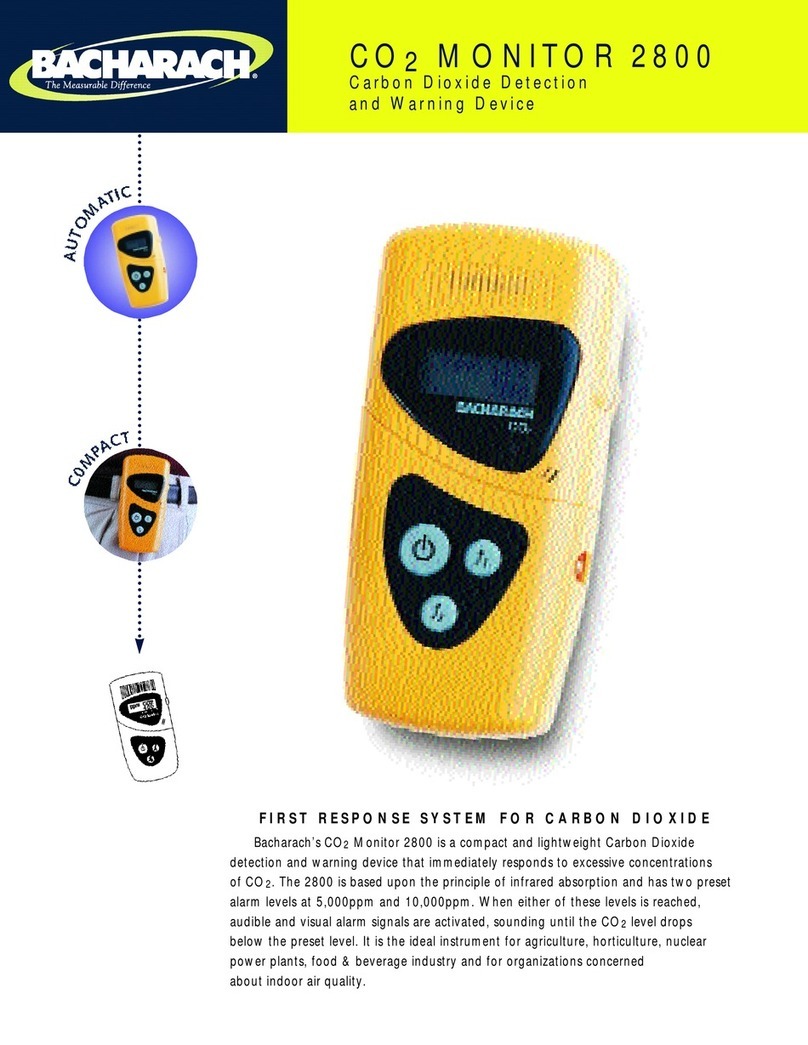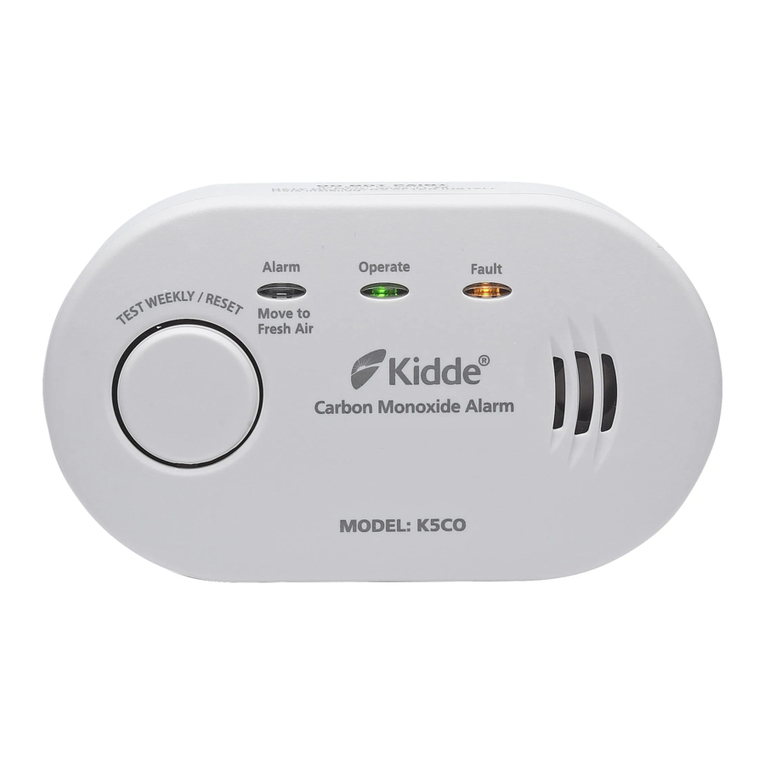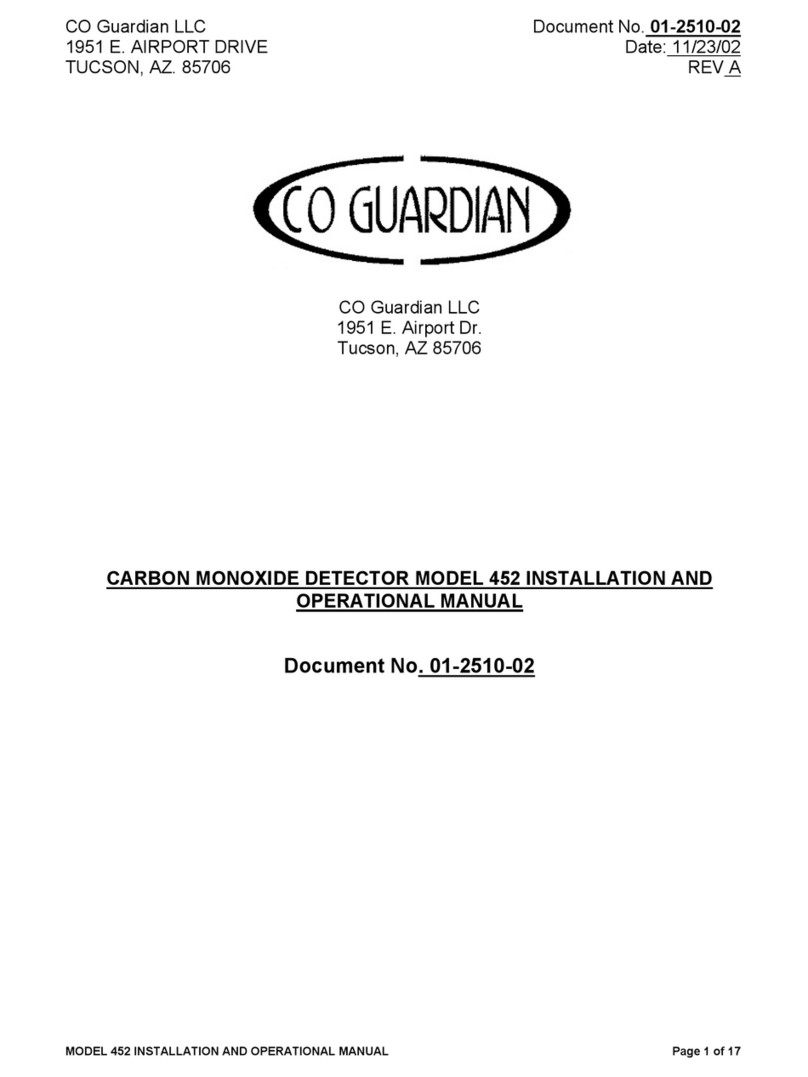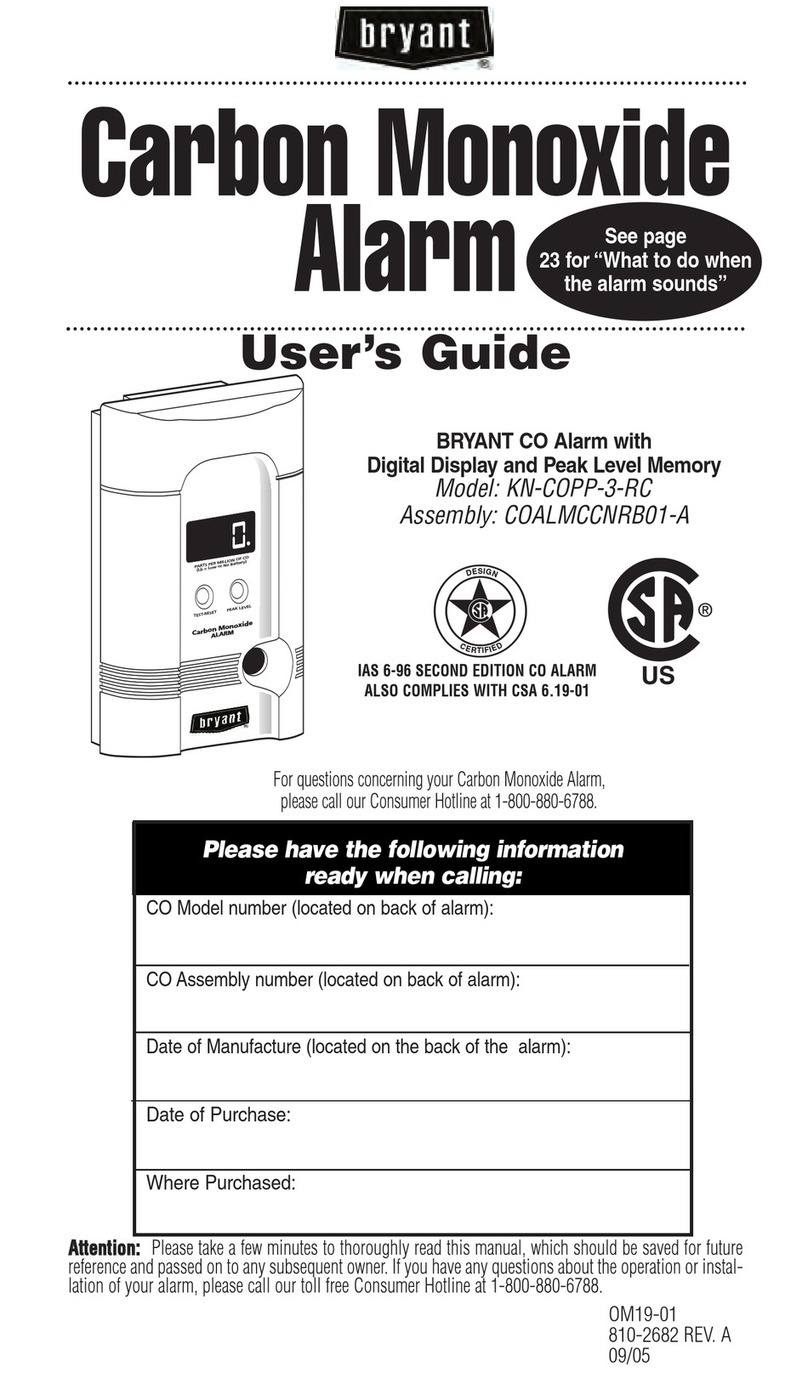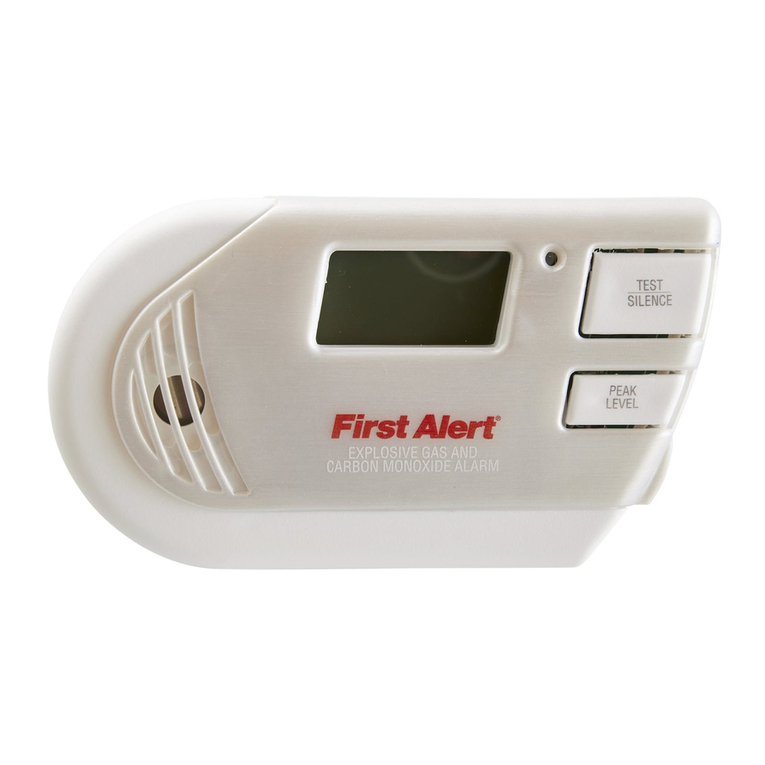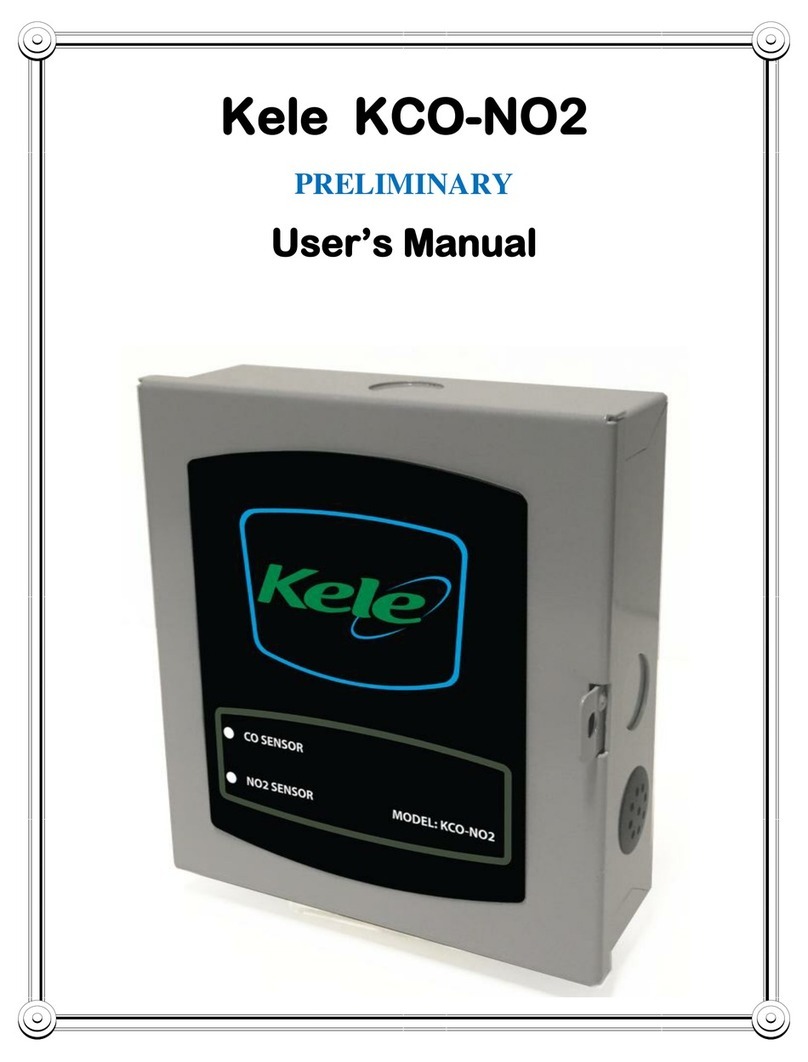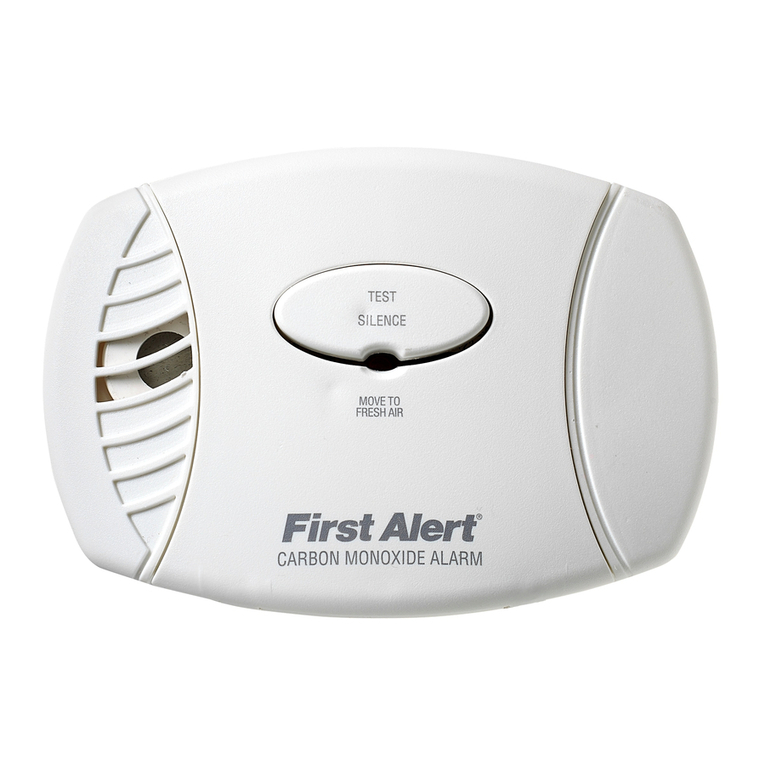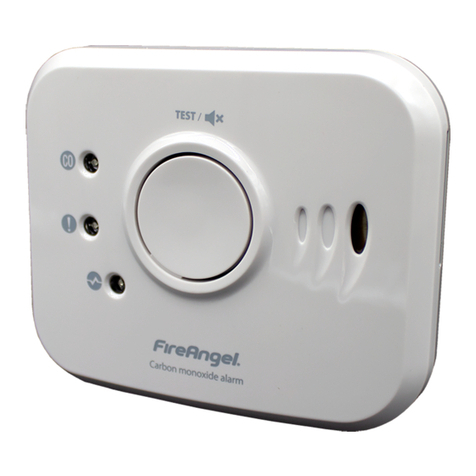Sprue Safety Products FireAngel CO-9X User manual

7YEAR LIFE
CARBON MONOXIDE
POISONOUS GAS ALARM
CO-9X User Manual

EN 50291-1:2010
+ A1:2012
EN 50291-2:2010
KM 551504
Sprue Safety Products Ltd.
Vanguard Centre, Sir William Lyons Road, Coventry CV4 7EZ UK
A Sprue Safety Products Brand
UK Gas Emergency Service Helpline: 0800 111 999
Technical Support: 0800 141 2561
EIRE dial: 1-800 523171
Email: technicalsupport@fireangel.co.uk
Web: www.fireangel.co.uk
CO-9X
GN0355R11

3
Features . . . . . . . . . . . . . . . . . . . . . . . . 4
Carbon monoxide and how it can affect you
and your family . . . . . . . . . . . . . . . . . . . . 4
Where to install your detector . . . . . . . . . . . . 9
How to install your detector . . . . . . . . . . . . 12
Power pack activation. . . . . . . . . . . . . . . . 13
Power pack deactivation . . . . . . . . . . . . . . 15
Operating features . . . . . . . . . . . . . . . . . 16
Understanding the product’s indicators . . . . . . 20
Maintaining / testing your detector . . . . . . . . 21
What to do in the event of an alarm . . . . . . . . 23
Technical information . . . . . . . . . . . . . . . . 24
Disposal . . . . . . . . . . . . . . . . . . . . . . . 25
Warranty . . . . . . . . . . . . . . . . . . . . . . . 26
Disabling tab storage page. . . . . . . . . . . . . 27
CONTENTS
Note: This user manual is also available
in large text and other formats. Please call
0800 141 2561 for further information.

4
FEATURES
• An advanced electrochemical sensor designed to
accurately measure low levels of carbon monoxide
(CO) providing an early warning of toxic CO levels in
your home.
• Detects carbon monoxide continuously.
• Resistant to false alarms caused by normal household
contaminants.
• Sounds a loud 85dB alarm (at 1metre (3 feet)) to alert
you in case of an emergency.
• Test/Silence button.
• Regular self-check to ensure detector is operating
correctly.
• Simple to mount, portable, ideal for travelling.
•
Certified to the European Carbon Monoxide Alarm
Standard EN 50291-1: 2010+A1:2012 and EN 50291-2: 2010.
• 7 year warranty.
• End of life indication.
CARBON MONOXIDE
AND HOW IT CAN AFFECTYOU
ANDYOUR FAMILY
Carbon monoxide is a dangerous, poisonous gas that
kills hundreds of people each year and injures many
more. It is often referred to as the silent killer because it
has no odour or taste and cannot be seen. Like oxygen,

5
CO enters the body through the lungs during the normal
breathing process. It competes with oxygen by replacing
it in the red blood cells, thereby reducing the flow of
oxygen to the heart, brain and other vital organs. In high
concentrations, CO can kill in minutes.
Many cases of reported carbon monoxide poisoning
indicate that while victims are aware they are not
feeling well, they become disorientated and unable to
save themselves by either exiting the building or calling
for assistance. Exposure during sleep is particularly
dangerous because the victim usually does not wake up.
Symptoms of CO poisoning
The following symptoms may be related to CO poisoning
which all household members should be made aware of:
• Mild Exposure: Slight headache, nausea, vomiting,
fatigue (often described as ‘flu-like’ symptoms).
• Medium Exposure: Severe throbbing headache,
drowsiness, confusion, fast heart rate.
• Extreme Exposure: Unconsciousness, convulsions,
cardiorespiratory failure, death.
Your CO detector monitors the level of CO as parts
per million (ppm) in the atmosphere surrounding the
detector.
35ppm The maximum allowable concentration for
continuous exposure for healthy adults in
any 8 hour period, as recommended by the
Occupational Safety and Health Administration
(OSHA).

6
200ppm Slight headache, fatigue, dizziness, nausea after
2 - 3 hours.
400ppm Frontal headaches within 1 - 2 hours, life
threatening after 3 hours.
800ppm Dizziness, nausea and convulsions within 45
minutes. Unconsciousness within 2 hours.
Death within 2 - 3 hours.
Should you suspect CO may be affecting you or your
family, open the doors and windows of your property
to ventilate, turn off your appliances and evacuate
the premises. At this time the authorities should be
contacted to locate the source of the carbon monoxide
before re-entering the building. Medical attention
should be sought for anyone suffering the effects of CO
poisoning.
Common sources of CO
• Oil and gas boilers
• Portable generators
• Oil or solid fuel cookers
• Gas or paraffin heaters
• Barbecues
• Clogged chimneys
• Wood or gas fireplaces
• Cigarette smoke
• Gas appliances
• Any fossil fuel burning appliance

7
WARNING: This carbon monoxide detector is not a
combustible gas detector, nor a smoke detector. Please
install the proper detectors to detect combustible gases,
or smoke.
This CO detector should not be seen as a substitute for
the proper installation, use and maintenance of fuel-
burning appliances (including appropriate ventilation
and exhaust systems), nor the sweeping of chimneys.
WARNING: Variables relating to your fuel burning
appliances can change at any point eg. the flue or
chimney could suddenly become blocked or damaged,
appliances may stop running correctly or circumstances
in neighbouring properties may change resulting in
the presence of carbon monoxide. For this and other
reasons do not use this carbon monoxide detector on an
intermittent basis, or as a portable detector for trying to
trace one source of the spillage of combustion products
from fuel-burning appliances or from chimneys.
Do not:
• IGNORE ANY WARNING FROMYOUR CO DETECTOR!
• Burn charcoal inside your home, caravan, tent or
cabin.
• Install, convert or service fuel-burning appliances
without proper knowledge, skill and expertise.
• Use a gas cooker for heating a room.
• Operate unvented gas burning appliances using
paraffin or natural gas in closed rooms.

8
• Operate petrol-powered engines indoors or in confined
areas.
• Barbecue indoors, or in an attached garage.
• Ignore a safety device when it shuts an appliance off.
Always:
• Buy appliances accepted by a recognised testing
laboratory.
• Install appliances according to the manufacturer’s
instructions.
• Have appliance installations carried out by
professionals (for gas appliances engineers should be
registered on the Gas Safe register).
• Have your appliances checked regularly by a qualified
service engineer.
• Have your chimneys and flues cleaned professionally
every year.
• Make regular visual inspections of all fuel-burning
appliances.
• Open windows when a fireplace or oil/solid fuel cooker
is in use.
• Only install CO detectors that meet the requirements
of EN 50291-1: 2010+A1:2012 and EN 50291-2: 2010 in
your home
• Be aware of CO poisoning symptoms.
• Educate yourself and your family on the sources
and symptoms of co poisoning and how to use your
carbon monoxide detector.

9
WHERE TO
INSTALL YOUR DETECTOR
This CO alarm is suitable for
use in domestic premises
(caravan holiday homes),
caravans, motor caravans and boats.
The following advice is applicable to all intended
applications, there are special instructions at the end of
this section relating to positioning in caravan holiday
homes, caravans, motor caravans and boats.
WARNING: This detector will only indicate the presence
of carbon monoxide gas at the sensor. Carbon monoxide
gas may be present in other areas.
In which room should the detector be installed?
Ideally, an apparatus should be installed in every
room containing a fuel-burning appliance. Additional
apparatus may be installed to ensure that adequate
warning is given for occupants in other rooms, by
locating apparatus in:
• Remote rooms in which the occupant(s) spend
considerable time whilst awake and from which they
may not be able to hear an alarm from apparatus in
another part of the premises, and;
• Every sleeping room.
However, if there is a fuel-burning appliance in more
than one room and the number of apparatus is limited,

10
the following points should be considered when
deciding where best to put the apparatus:
• Locate the apparatus in a room containing a flueless or
open-flued appliance, and;
• Locate apparatus in a room where the occupant(s)
spend most time.
• If the domestic premises is a bedsit (a single room
serving as both sitting and bedroom) then the
apparatus should be put as far from the cooking
appliances as possible but near to where the person
sleeps.
• If the appliance is in a room not normally used (for
example a boiler room), the apparatus should be put
just outside the room so that the alarm may be heard
more easily. Alternatively, a remote alarm siren may be
connected to a type A apparatus located in a room(s)
containing a fuel-burning appliance.
Where in the room should I place the detector?
Apparatus located in the same room as a fuel-burning
appliance, for both wall and ceiling mounted apparatus
the following applies:
a. The apparatus should be at a horizontal distance of
between 1m and 3m from the potential source.
b. If there is a partition in a room, the apparatus should
be located on the same side of the partition as the
potential source.
c. Carbon monoxide detectors in rooms with sloped
ceilings should be located at the high side of the
room.

11
In addition to the above the following must be observed if
the apparatus is located on a wall:
a. It should be located close to the ceiling;
b. It should be located at a height greater than the height
of any door or window;
c. It should be at least 150mm from the ceiling.
If the apparatus is located on the ceiling it should be at
least 300mm from any wall and any ceiling obstruction
e.g. light fittings.
Apparatus located in sleeping rooms or located in rooms
remote from the fuel-burning appliance should be located
relatively close to the breathing zone of the occupants.
Caravans and boats
Caravans and boats may have additional risks of carbon
monoxide ingress through air vents due to the nearby
presence of other vehicles, engines, generators or
barbecues, however this does not change the basic
guidance on location of the alarm. Caravans and boats
should be fitted with an alarm in the same room as
any combustion appliance(s), located in accordance
with previous advice in this section. If the caravan has
a single living space which incorporates the sleeping
accommodation, it can be considered to be equivalent
to a bedsit, and a single alarm is sufficient. However, any
sleeping accommodation which is in a separate room
from the combustion appliance(s) should also contain an
alarm, located in accordance with previous advice in this
section.

12
It is not always possible to find an optimum location
for an apparatus, for example, a small caravan may not
have suitable vertical surfaces available. Nevertheless,
when fitting an apparatus in such situations, the two most
important considerations when selecting an appropriate
location are:
• Not mounting the apparatus directly above a source of
heat or steam; and
• Mounting the apparatus at a distance of 1 – 3 m from
the nearest edge of the potential source.
HOW TO
INSTALL YOUR DETECTOR
NOTE:This apparatus should be installed by a competent
person who feels able to install it according to the
instructions.
Firstly write the installation date on your detector in
the area provided. We recommend that your detector is
installed on the wall.
66mm
Drill hole spacing

13
To mount on a wall or ceiling:
Please ensure that you use the screws provided, as they
were chosen specifically for use with this product. Use the
template provided for guidance on marking hole positions.
Drill holes into the wall. Insert the plastic wall plugs. Screw
in the screws. Ensure screws are protruding from the wall
by 3mm to allow detector to slot onto screws.
To place on a shelf:
The base of the detector has been designed to allow it to
stand freely on a shelf.
WARNING: When placing on a shelf, please adhere to
the same positional recommendations as described on
previous pages.
POWER PACK ACTIVATION
a Your detector comes complete with an integrated power
pack that will provide power for its entire operational
life. To activate the power pack you need to pull the
disabling tab (see image). This will in turn pull out the
metal disabling clip, which is attached to the end of the
tab, from the disabling socket which is situated on the
underside of the detector. Retain the disabling tab for
future use by taping it to page 27 of this manual.

14
b When the detector is activated the Power LED will begin
to flash green once every minute to indicate that the
detector is receiving power from the power pack and is
fully operational.
c Test the sounder, power pack and circuitry by pressing
and holding the centre of the Test/Silence button briefly
to confirm that the detector is operating properly. The
sounder will sound as soon as the button is pressed,
and the Alarm LED will illuminate red indicating that
the sounder is working and the power pack is providing
power to the unit. This test for the sounder, power pack
and circuitry should be performed on a weekly basis.

15
This should be continued for the lifetime of the product.
WARNING: Prolonged exposure to the sounder in close
proximity to your ears may damage your hearing.
Under normal operating conditions, the power pack will
last for the lifetime of the product ie. 7 years.
The detector will not protect against the risk of carbon
monoxide poisoning when the power pack has drained.
WARNING: Prolonged exposure to extreme high or low
temperatures may reduce the life of the power pack.
POWER PACK DEACTIVATION
Your CO-9X is portable, making it ideal for taking with you
on holiday.You will need to deactivate your detector when
travelling or even when storing. Fitting is the reverse of
removal.
The clip must
remain in the
disabling socket
to keep the power
pack deactivated.

16
To deactivate the detector the two ends of the metal clip
must be inserted into the corresponding holes in the
disabling socket located on the underside of the detector.
You can ensure that the product is disabled by pressing
the test button - if there is no sound from the sounder then
the clip has been fitted correctly.
NOTE: If the disabling tab is no longer available then the
clip can be replicated by opening out a thin metal paper
clip into a U-shape.
OPERATING FEATURES
Your detector offers many features which set it apart from
other CO detectors on the market today:
Test/Silence button feature
• Tests the sounder, power pack and circuitry.
• Allows you to test the sensor by introducing a source
of CO into the detector.
• Silences the loud 85dB (at 1 metre (3 feet)) sounder
during an alarm (only for alarms due to levels of CO of
less than 50ppm).
Testing the sounder, power pack and circuitry
Test the sounder, power pack and circuitry by pressing
and releasing the Test/Silence button to confirm that the
detector is operating properly. The sounder should sound
as soon as the button is pressed, and the Alarm LED will
illuminate red indicating that the sounder is working
and the power pack is providing power to the unit. This

17
test for the sounder, power pack and circuitry should be
performed on a weekly basis.
Testing the sensor
CAUTION: Sensor testing should only be performed by
a responsible adult. This test should only be performed
once a year. Excessive testing will cause the life of the
power pack to be shortened.
NOTE: Aerosol CO may be used in order to avoid having
to burn incense sticks.
Read all steps thoroughly before attempting the sensor
test.
Step 1 If the detector is wall or ceiling mounted
unhook the detector from the screws.
Step 2
Cover the sounder vents with one hand.

18
Press and hold theTest/Silence button down
with your thumb/finger until the Fault LED
illuminates yellow and the sounder sounds
for a second time (this should happen after
around 5 seconds). Release theTest/Silence
button. Upon releasing theTest/Silence button
the Fault LED will flash yellow once every
second.This indicates that the sampling rate of
the detector has increased and can be tested
using a known source of CO.
Step 3 Light an incense stick using a match or lighter.
Be sure to blow out the flame so that the
incense stick is smouldering. Extinguish the
lighter, or put out the match and place it into a
dish of water.

19
Step 4
15cm
(6”)
Turn the detector on its side so that the vents
on the right hand side of the detector are
pointing downwards. Hold the burning incense
stick 15 cm (6 inches) below the detector, so
that the smoke enters the vents on the side
of the detector. An increase in the localised
carbon monoxide level within the sensor to
more than 50ppm will cause the sounder to
sound for one cycle of four loud beeps and the
Fault LED to illuminate yellow for a short time.
This is the end of the test.

20
The Fault LED will no longer flash yellow and
the detector will go back to normal operating
mode ie. the Power LED will flash green once
every minute (it may take up to two minutes of
exposure to the smoke for the localised level
of carbon monoxide within the sensor to reach
over 50ppm). Now move the source of CO
away from the detector as the test is finished.
Step 5 After step 4, put out the incense stick by
placing it into a dish of water. Ensure that all
flames have been extinguished.
NOTE: If the localised carbon monoxide level within the
sensor does not reach 50ppm during the test, the sensor
test will stop automatically after 3 minutes.
UNDERSTANDING THE
PRODUCT’S INDICATORS
The higher the concentration of carbon monoxide detected
by the detector, the quicker it will respond. When sufficient
carbon monoxide is detected a loud audible signal (85 dB
at 1m (3 feet)) will be emitted and the Alarm LED will flash
red once every second.
The Alarm will sound:
• Between 60 and 90 minutes when exposed to 50ppm
of CO.
• Between 10 and 40 minutes when exposed to 100ppm
of CO.
This manual suits for next models
2
Table of contents
Popular Carbon Monoxide Alarm manuals by other brands
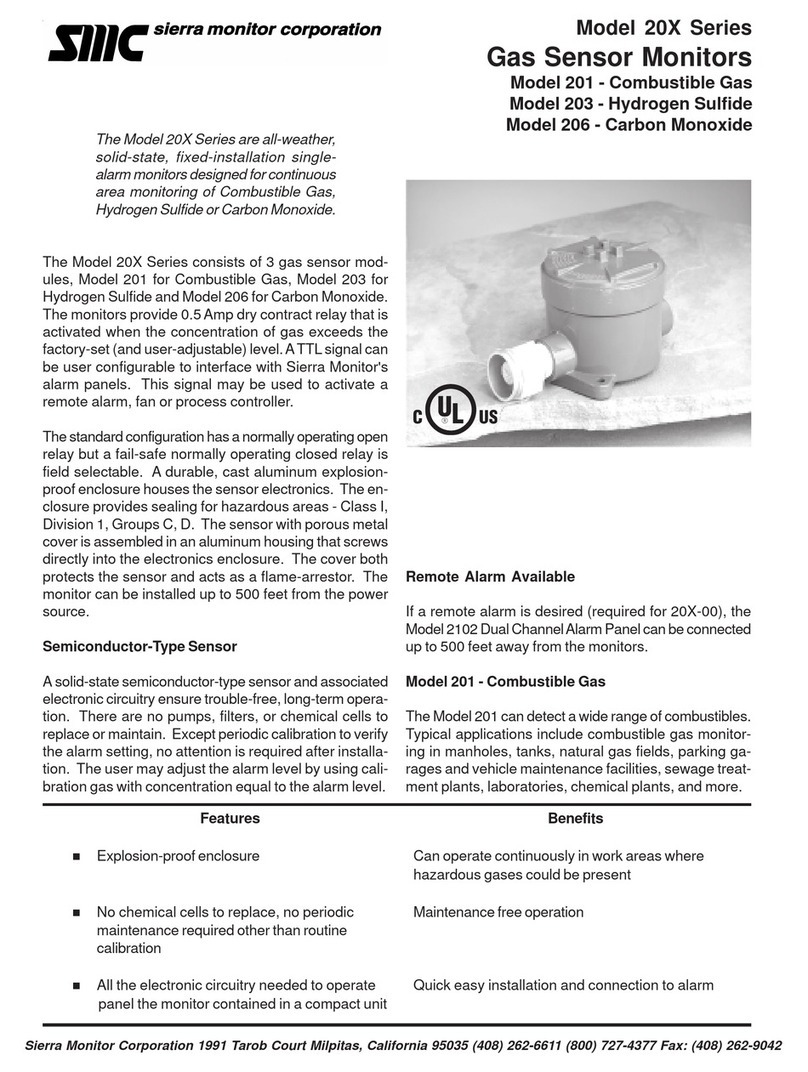
Sierra Monitor Corporation
Sierra Monitor Corporation 201 Specifications
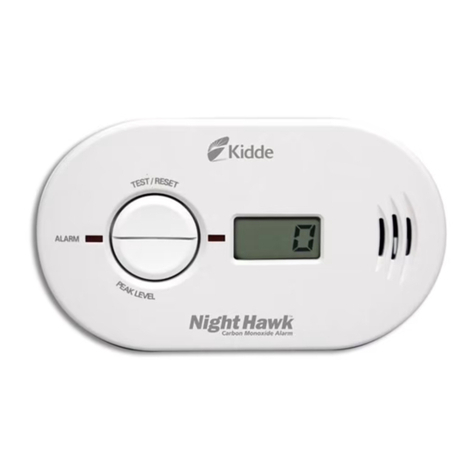
Kidde
Kidde KN-COB-B-LS user guide
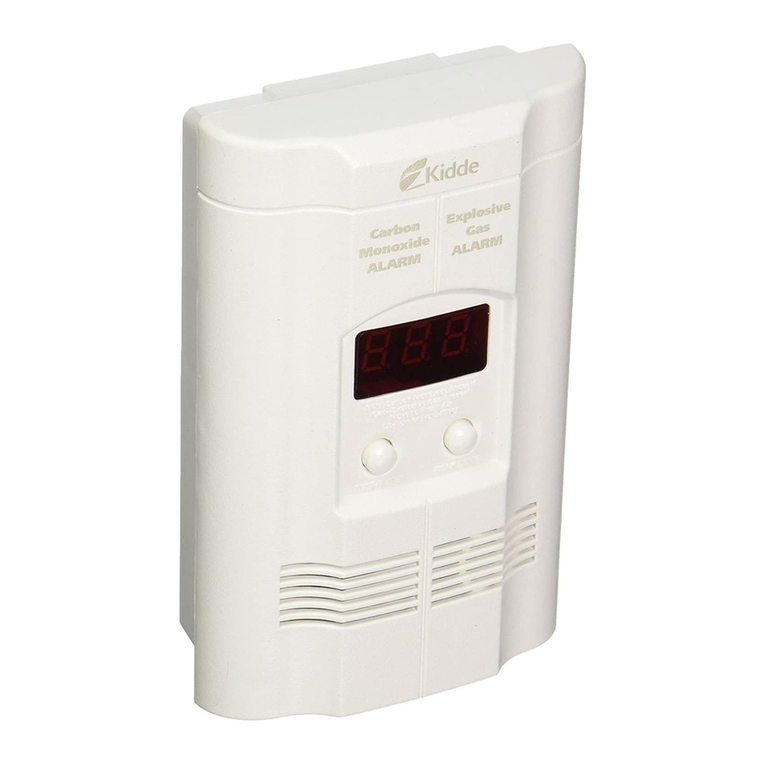
Kidde
Kidde KN-COEG-3 (900-01 13) user guide
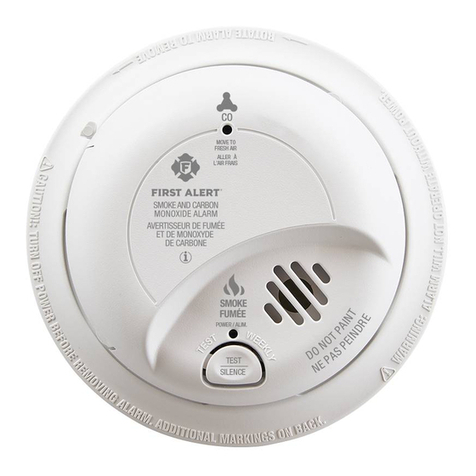
BRK electronic
BRK electronic First Alert SC9120BA user manual

Tracon Electric
Tracon Electric CO218A user manual
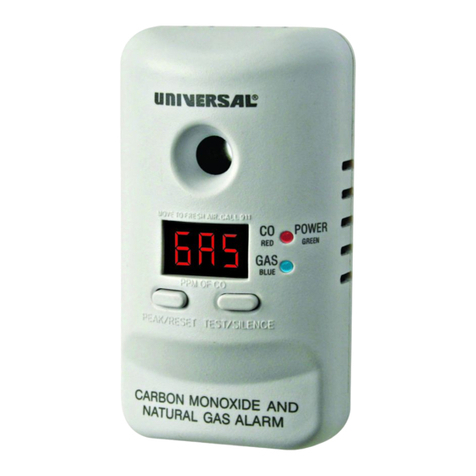
Universal Security Instruments
Universal Security Instruments MCN400 manual
